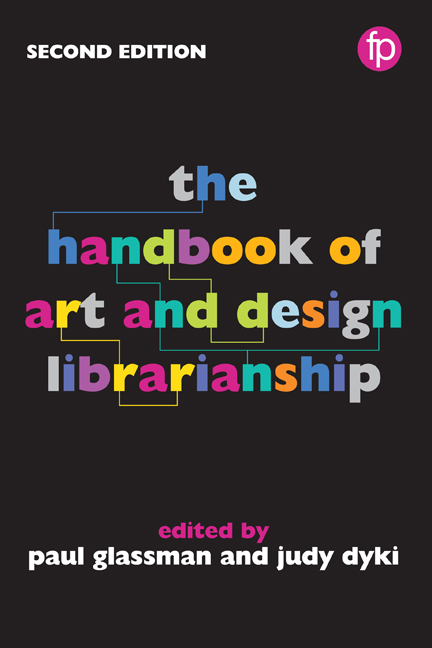Book contents
- Frontmatter
- Contents
- List of figures and tables
- Notes on contributors
- Foreword
- Preface
- Part I Roles and responsibilities
- Part II Materials and collection management
- 6 Visual resources: from analogue to digital and beyond
- 7 Developing digital collections
- 8 Inspirational encounters: the management and use of archives and special collections in the art and design library
- 9 What is special about special collections?
- 10 Artists’ books in the art and design library
- 11 Art documentation: exhibition catalogues and beyond
- 12 Tactile libraries: material collections in art, architecture and design
- 13 Seeing the bigger picture: archival description of visual information
- Part III Teaching and learning
- Part IV Knowledge creation
- Part V The physical environment
- Part VI Promotion and sustainability
- Appendix Library profiles
- Index
7 - Developing digital collections
from Part II - Materials and collection management
Published online by Cambridge University Press: 08 June 2018
- Frontmatter
- Contents
- List of figures and tables
- Notes on contributors
- Foreword
- Preface
- Part I Roles and responsibilities
- Part II Materials and collection management
- 6 Visual resources: from analogue to digital and beyond
- 7 Developing digital collections
- 8 Inspirational encounters: the management and use of archives and special collections in the art and design library
- 9 What is special about special collections?
- 10 Artists’ books in the art and design library
- 11 Art documentation: exhibition catalogues and beyond
- 12 Tactile libraries: material collections in art, architecture and design
- 13 Seeing the bigger picture: archival description of visual information
- Part III Teaching and learning
- Part IV Knowledge creation
- Part V The physical environment
- Part VI Promotion and sustainability
- Appendix Library profiles
- Index
Summary
In the late 2000s manuals, such as Terry Reese and Kyle Banerjee's Building Digital Libraries (2007), provided a detailed guide to the creation of digital collections. This chapter does not seek to supplant the guidance provided in this and other texts, but to focus on the best practices, to emphasize the fluid nature of collection building and to recognize potential beyond the collection to create new knowledge and interoperability.
Introduction to digital collections
Institutions, groups and individuals create digital collections that comprise a number of different types. A collection might stand alone (for a course or an exhibition), serve as a digital archive, contribute to a digital humanities project, enhance an institution's digital repository, or aggregate a multiple collections, such as Artstor or the Digital Public Library of America (DPLA; https://dp.la/).
Regardless of type, all digital collections have two basic components: the digital file and its associated metadata. This is true whether the original materials are textual, visual, audio, video or three-dimensional objects. The digital file can either be born-digital, such as an image captured using a digital camera or created on a computer, or it can be a digital surrogate of an analogue original. The associated metadata includes descriptive, adminis - trative, technical and preservation metadata that aid in the discovery, use and management of the digital file. The content of your collection determines some of the decisions you will make regarding file types, metadata schema and presentation possibilities. Whether your collection is temporary or permanent, institutional or aggregated, or focused on art, science or history, the same rules and best practices apply.
Getting started
Motivators for planning and building digital collections include preservation of rare or fragile materials, providing access to unique or valuable materials, and increasing exposure to all collection items.
No matter the reason for building a collection, there are several questions you will want to answer as you develop a project plan and workflow. Good planning eases the format migration, data creation and the pursuit of future projects. It also enables simultaneous sharing of content in multiple venues. The only constant in digital collections is change, and you need to be sure your content can adapt to new technology and tools for storage, access and delivery.
- Type
- Chapter
- Information
- The Handbook of Art and Design Librarianship , pp. 63 - 74Publisher: FacetPrint publication year: 2017

